Because root canal treatment, or Endodontics is less common than simple fillings, and because it takes place inside the tooth, out of site, it is less well understood. This means that it is one of the treatments in dentistry which has traditionally instilled fear and dread among patients. We actually find that during root canal many patients fall asleep from boredom. Root canal should not be uncomfortable. There is nothing nasty, so we find it helps if you know what awaits you.
Assessing and Isolating
Once we assess the tooth, usually done both visually and by dental x-rays, we numb up the area to ensure comfort.
We use a technique called rubber dam, or dental dam, which helps stop water going down the back of your throat, and also helps stop bacteria going down the tooth. Although the rubber dam may seem strange at first, we find the vast majority of patients prefer it, firstly because your mouth is not filling with water, and secondly, it can almost seem like you are one side and the dentists is working on something that is not yours!
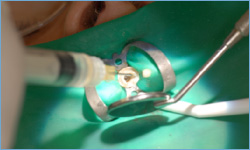
This photograph shows a tooth through the rubber dam.
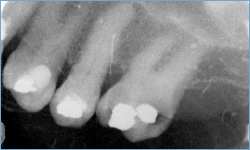
This x-ray shows a tooth with a large filling in it, which has leaked, and is now surrounded by decay. It can often be that the nerve of a tooth either gives troubles immediately after a filling is placed, or several years later, as was the case here.
There is then some work to clean the top of the tooth, and locate the fine canals. For this we use high power magnification, as the canals can initially be just hundredths of a millimeter in diameter.
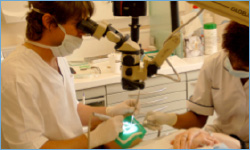
This shows the endodontist working under the high powered magnification provided by a microscope, and the view he gets.
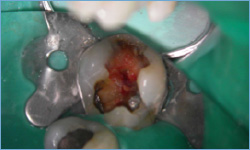
This shows the endodontist working under the high powered magnification provided by a microscope, and the view he gets.
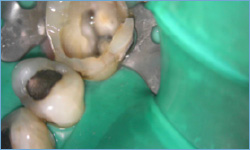
With the decay removed, he can see the canals clearly, they are the little black dots.
Cleaning and Shaping
This stage is very much like the hygienist polishing the outside of your tooth, except it is done on the inside.
The canals themselves are shaped to allow us to remove any debris and bacteria. Another very important aspect is that the canals are rinsed with a bleach to kill and dissolve the bacteria. This is an area of root canal on which one of our dentists has several International publications.
During this process we confirm the length of the tooth. For this we will use a combination of x-rays and a specialist root canal device which helps us to be accurate to within fractions of a millimeter.
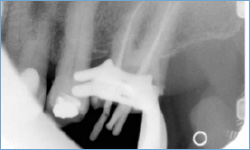
This shows the tooth, after shaping, and with a trial fitting of the root filling material
Filling the Root Canal System
Once we are happy that the shape of the tooth is good, we can fill the root canal system. We use a rubber based material for this. Using a combination of precision pre-formed materials, heat compaction and more specialist root canal instruments, we fill the canal system, and obtain an x-ray to allow us to check the final filling and to serve as a base-line for us to monitor.
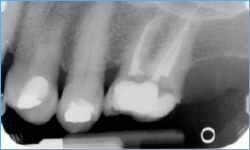
This shows the same tooth once we have filled it. Each canal is filled right to the end, and there are no gaps in the root filling material This level of detail helps us achieve the highest success rates possible
After the Root Canal
The most common finding afterwards is that there is no difference to a routine filling. Sometimes it might be necessary to take a couple of pain-killers. Sometimes infections can temporarily recur, and we may need to give anti-biotics, but typically this is less than 10% of the time.
It has also been shown that for the back teeth in particular, the long term success can be improved by placing a crown on top of this. Your dentist, either here or Seven Fields or at your own practice, if you have been referred, can advise you about this.








